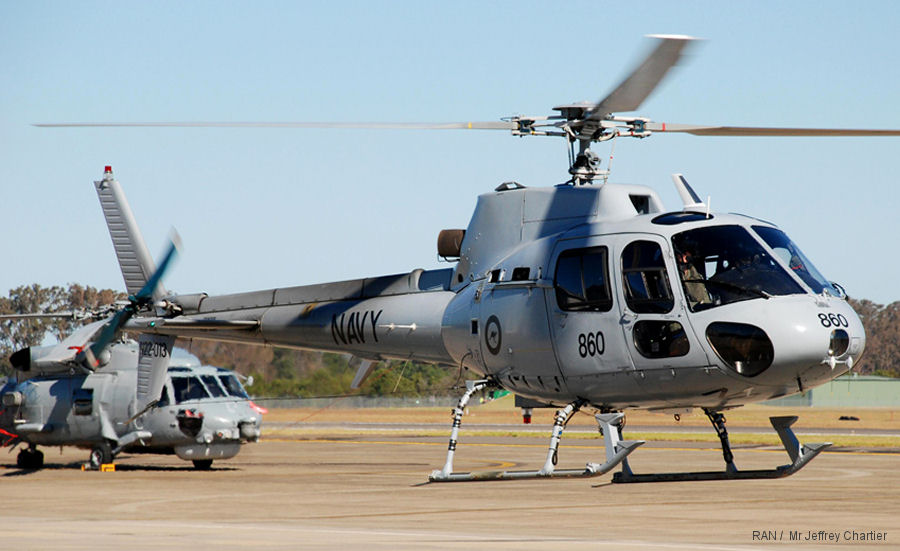
The Seahawk has been in the Fleet Air Arm inventory for 29 years and was operationally deployed in the Middle East throughout its entire service history.
The Squirrel has served for 33 years amassing an enviable record in both operations and training.
Commander Fleet Air Arm, Commodore Chris Smallhorn said both aircraft had a proud record of service to the nation.
“Today we farewelled two magnificent aircraft with pride in our heart and tears in our eyes,” he said.
“The AS350BA Squirrel has proven to be one of the most successful airframes in naval aviation history.
“During the 1990-91 Gulf War the Squirrel carried out shipping surveillance, mine searches and top cover for helicopter boarding operations.
“It was also deployed in East Timor and on numerous disaster relief operations, including the 2001 'Black Christmas Bushfire' crisis and the 2011 South East Queensland and Victoria floods.
The Last Three Decades
“Over the last three decades the majority of naval aviators have trained in the Squirrel and many, including myself, have wonderfully fond memories of their time flying the ‘Cyril’ as many affectionately referred to the AS350.
“A machine that has served its country in peace and war and across three services, it’s a truly impressive chapter in Navy’s story,” Commodore Smallhorn said.
The S-70B-2 Bravo Seahawk was designed specifically for Navy’s needs when it was introduced in 1989, without doubt the most advanced maritime helicopter at that time.
Labelled a Role Adaptable Weapons System due to the flexibility it brought to the Fleet, the S-70B-2 was proved a magnificent combat helicopter for anti-submarine and surface operations, and proved exceptional in its secondary utility type missions.
The Bravo Seahawk has also come to the assistance of countless Australians and friends of Australia alike, fighting fires, flood and extreme weather events along with conducting many challenging rescue operations at sea, one of the most famous and difficult being during the ill-fated the 1998 Sydney to Hobart yacht race.
“The operational and safety record of the Bravo is exceptional by any measure,” Commodore Smallhorn said.
“Today’s ceremony was of course a tribute to the aircraft, but more so in my view to the sailors and officers who maintained and flew these aircraft, and to the extraordinary, and at time herculean, efforts of the military, public service and industry folks who make up the support agencies and systems that kept these complex weapon systems on the front line each day.
“Every one of these people deserves the gratitude of their Navy and their nation – well done.
“No matter how good our equipment is, the quality of our operational footprint is measured by the dedication of the people who make it tick.”
Chief Petty Officer Michael Bryan, an aviation technician at 816 Squadron is one of those dedicated personnel, having worked on the Bravo Seahawk since 1993.
“I have grown up in the Navy with and around the Bravo,” Chief Petty Officer Bryan said.
“They are the most versatile aircraft and weapons platform for embarked operations ever purchased by the Navy.
“This is evidenced through the desire by all major Fleet units to have a Bravo embarked and looking at 816 Squadron’s honour board.”
Chief Petty Officer Bryan said one of the most enjoyable aspects of working on the Bravo were the opportunities it provided, professionally and personally.
“I have had a chance to sail around a fair portion of the globe in my time with the Bravo,” he said.
“I also value the friendships I developed while working on the Bravo and consider my colleagues not just work mates but lifelong friends.”
Lieutenant Commander Tony Reyne, Squirrel Instructor and Maintenance Test Pilot, and the only recipient of the Fleet Air Arm 10,000 flying hours patch has had a 35 year association with 723 Squadron and is retiring from the Royal Australian Navy at the same time as the Squirrel.
“I will miss is the camaraderie of those who flew and worked on the Squirrel with me, it has been a great time with a great team,” Lieutenant Commander Reyne said.
The retirement of the two aircraft was done as part of Ceremonial Divisions at HMAS Albatross and Chief of Navy, Vice Admiral Tim Barrett, a fellow aviator, took the opportunity to congratulate Albatross on the fine turn out.
“The work done here at Albatross is not always easy and it is very important for the nation,” he said.
“Whether you are a logistician, a maintainer or an operator; whether you are part of a project, a training organisation, or an enabling service your role is important in ensuring that the squadrons, commands, services and groups can achieve the operational outputs required of us by government and ultimately the Australian people. Thank you.”
See also |
S-70B-2 Seahawk in
AS350 Ecureuil in




